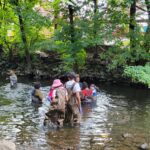The birch bark canoe is closely associated with the popular image of the Native Americans, and it lent its classic form to the polypropylene craft that today proudly bear the logo of the Bronx River Alliance. But the Native Americans originally paddled the waters of the Aquahung in wooden dugout canoes.
The durable Wapim-inisi, or American Chestnut, was the Lenape canoe maker’s wood of choice, shaped by alternately burning and scraping a felled tree trunk with stone tools. This laborious process was more efficient than it seems – it took a single canoe builder about 10-12 days of steady work to turn out a smartly finished craft. Examples found in this area and depicted in Dutch drawings often included long extensions fore and aft, handy for hauling the canoe ashore and securing it with a rope woven from hemp dogbane.
There were two types of dugout canoes in the Lenape language, mahelo and amochol. The word mahelo probably referred to the larger models, and these could be pretty sizeable craft: trunks up to 40 feet long were fashioned into four-passenger canoes that could manage journeys out into the East River and as far out as Coney Island and the Rockaways. Long Island natives even built mammoth six-man dugouts for whale hunting.
Stephen Paul DeVillo




